KINGS
I KINGS 5:17; 6:7 ~ King Solomon commanded them to cut out big, expensive stones to be the foundation for the temple. These stones were carefully cut….The workers used large stones to build the walls. The workers cut the stones at the place where they got them out of the ground. So there was no noise of hammers, axes, or any other iron tools in the temple. = الملوك الأول الفصل 5 – الملوك الأول الفصل 6
17 وَأَمَرَ الْمَلِكُ أَنْ يَقْلَعُوا حِجَارَةً كَبِيرَةً كَرِيمَةً مُرَبَّعَةً لِتَأْسِيسِ الْبَيْتِ.
7 وَالْبَيْتُ فِي بِنَائِهِ بُنِيَ بِحِجَارَةٍ صَحِيحَةٍ مُقْتَلَعَةٍ، وَلَمْ يُسْمَعْ فِي الْبَيْتِ عِنْدَ بِنَائِهِ مِنْحَتٌ وَلاَ مِعْوَلٌ وَلاَ أَدَاةٌ مِنْ حَدِيدٍ.
I KINGS 7:9-12 ~ All of these buildings were made with expensive blocks of stone. These stones were cut to the right size with a saw. They were cut in the front and in the back. These expensive stones went from the foundation up to the top layer of the wall. Even the wall around the yard was made with expensive blocks of stone. The foundations were made with large, expensive stones. Some of the stones were 10 cubits long and others were 8 cubits long. = الملوك الأول الفصل 7
9 كُلُّ هَذِهِ مِنْ حِجَارَةٍ كَرِيمَةٍ كَقِيَاسِ الْحِجَارَةِ الْمَنْحُوتَةِ مَنْشُورَةٍ بِمِنْشَارٍ مِنْ دَاخِلٍ وَمِنْ خَارِجٍ مِنَ الأَسَاسِ إِلَى الإِفْرِيزِ وَمِنْ خَارِجٍ إِلَى الدَّارِ الْكَبِيرَةِ.
10 وَكَانَ مُؤَسَّساً عَلَى حِجَارَةٍ كَرِيمَةٍ عَظِيمَةٍ، حِجَارَةِ عَشَرِ أَذْرُعٍ، وَحِجَارَةِ ثَمَانِ أَذْرُعٍ.
11 وَمِنْ فَوْقٍ حِجَارَةٌ كَرِيمَةٌ كَقِيَاسِ الْمَنْحُوتَةِ، وَأَرْزٌ.
12 وَلِلدَّارِ الْكَبِيرَةِ فِي مُسْتَدِيرِهَا ثَلاَثَةُ صُفُوفٍ مَنْحُوتَةٍ وَصَفٌّ مِنْ جَوَائِزِ الأَرْزِ. كَذَلِكَ دَارُ بَيْتِ الرَّبِّ الدَّاخِلِيَّةُ
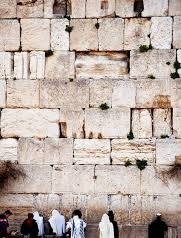
Temple foundation stones today
At the southeast corner of the Temple area, the wall rises 77 feet. It is 156 feet. Its cornerstone is 14’ long, 4’ high. Solomon’s repairs (11:27) are plainly indicated.
Archaeologist Barkley discovered the quarry from which Jerusalem’s great stones were taken. It is now an immense cavern extending under the area close to where the temple was built. The entrance is near the Damascus gate. Partly cut stones are there; from which their methods of quarrying were learned. Little holes were cut in the rocks to hold candles by which the men worked in pitch darkness

Interior of quarry showing where stones were cut
One of the methods for hewing the stones was to carve broad slits along the rock face, and to drive dry wooden wedges into them. Water was then poured over the dry wedges, so causing them to swell. The resulting pressure then cracked the stone along the slits. This primitive method of quarrying was quite effective, and traces of it can still be found in the cave.
I KINGS 9:15,19; 10:26 ~ Then he built again the cities of Hazor, Megiddo, and Gezer….King Solomon also built cities where he could store grain and things. And he built places for his chariots and his horses….So Solomon had many, many chariots and horses. He had 1,400 chariots and 12,000 horses. Solomon built special cities for these chariots. So the chariots were kept in those cities. King Solomon also kept some of the chariots with him in Jerusalem. = الملوك الأول الفصل 9 – الملوك الأول الفصل 10
15 وَهَذَا هُوَ سَبَبُ التَّسْخِيرِ الَّذِي جَعَلَهُ الْمَلِكُ سُلَيْمَانُ لِبِنَاءِ بَيْتِ الرَّبِّ وَبَيْتِهِ وَالْقَلْعَةِ وَسُورِ أُورُشَلِيمَ وَحَاصُورَ وَمَجِدُّو وَجَازَرَ.
19 وَجَمِيعَ مُدُنِ الْمَخَازِنِ الَّتِي كَانَتْ لِسُلَيْمَانَ، وَمُدُنَ الْمَرْكَبَاتِ وَمُدُنَ الْفُرْسَانِ، وَمَرْغُوبَ سُلَيْمَانَ الَّذِي رَغِبَ أَنْ يَبْنِيَهُ فِي أُورُشَلِيمَ وَفِي لُبْنَانَ وَفِي كُلِّ أَرْضِ سَلْطَنَتِهِ.
26 وَجَمَعَ سُلَيْمَانُ مَرَاكِبَ وَفُرْسَاناً. فَكَانَ لَهُ أَلْفٌ وَأَرْبَعُ مِئَةِ مَرْكَبَةٍ وَاثْنَا عَشَرَ أَلْفَ فَارِسٍ، فَأَقَامَهُمْ فِي مُدُنِ الْمَرَاكِبِ وَمَعَ الْمَلِكِ فِي أُورُشَلِيمَ.
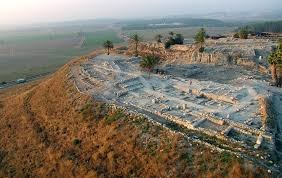
Excavation of Megiddo
The Oriental Institute uncovered in Megiddo the ruins of two separate stable complexes where Solomon kept his horses. The buildings were about twenty-one meters long by eleven meters wide. Separating the main corridor from outside aisles was a series of stone pillars.
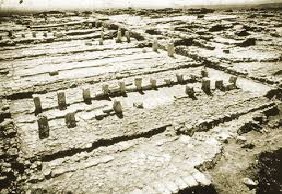
Solomon’s Stables at Megiddo
Holes were bored into many of these pillars so that horses could be tied to them. Also, the remains of stone mangers were found in the buildings. These mangers were placed between the pillars to feed the horses. The capacity of the northern buildings was about three hundred horses altogether. Both complexes could hold from 450-480 horses combined.
(See Joshua above for pictures of Hazor and Gezer.)
I KINGS 9:26-28; 10:14-15 ~ King Solomon also built ships at Ezion Geber. This town is near Elath on the shore of the Red Sea, in the land of Edom. King Hiram had some men who knew much about the sea. Those men often traveled in ships. King Hiram sent those men to serve in Solomon’s navy and work with Solomon’s men. Solomon’s ships went to Ophir. The ships brought about 31,500 pounds of gold back from Ophir to King Solomon….Every year King Solomon got about 79,920 pounds of gold. Besides the gold from the cargo ships, he also got gold from the traders and merchants, and from the kings of Arabia and governors of the land. = الملوك الأول الفصل 9 – الملوك الأول الفصل 10
26 وَعَمِلَ الْمَلِكُ سُلَيْمَانُ سُفُناً فِي عِصْيُونَ جَابِرَ الَّتِي بِجَانِبِ أَيْلَةَ عَلَى شَاطِئِ بَحْرِ سُوفٍ فِي أَرْضِ أَدُومَ.
27 فَأَرْسَلَ حِيرَامُ فِي السُّفُنِ عَبِيدَهُ النَّوَاتِيَّ الْعَارِفِينَ بِالْبَحْرِ مَعَ عَبِيدِ سُلَيْمَانَ،
28 فَأَتُوا إِلَى أُوفِيرَ، وَأَخَذُوا مِنْ هُنَاكَ ذَهَباً أَرْبَعَ مِئَةِ وَزْنَةٍ وَعِشْرِينَ وَزْنَةً، وَأَتُوا بِهَا إِلَى الْمَلِكِ سُلَيْمَانَ.
14 وَكَانَ وَزْنُ الذَّهَبِ الَّذِي أَتَى سُلَيْمَانَ فِي سَنَةٍ وَاحِدَةٍ سِتَّ مِئَةٍ وَسِتّاً وَسِتِّينَ وَزْنَةَ ذَهَبٍ.
15 مَا عَدَا الَّذِي مِنْ عِنْدِ التُّجَّارِ وَتَجَارَةِ التُّجَّارِ وَجَمِيعِ مُلُوكِ الْعَرَبِ وَوُلاَةِ الأَرْضِ
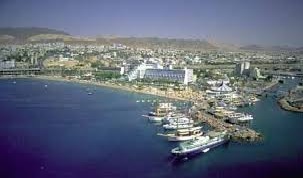
Elath today near Solomon’s Navy port Ezion Geber
King Solomon made a navy of ships at Ezion-geber. It was for his trade with Arabia, India and the east coast of Africa. Ezion-geber was situated at the north end of the Gulf of Akahba on the Red Sea. Archaeologist Nelson Glueck of the American Schools of Oriental Researcfh excavated the ruins of Solomon’s smelters, furnaces, crucibles, and refineries there. He also found copper and iron ore deposits in the vicinity, of which dishes, nails, spearheads and fishhooks were manufactured and exported in exchange for ivory and gold.
Coral Island has been identified as Ezion-geber. Its harbor was obviously a busy port at one time. The island is 7 miles (11 km) south of Eilat in Egyptian waters. The waters between the island and the Sinai mainland are a natural anchorage, protecting ships. Remains of two “dolphins,” (building stones used as offshore piers) are underwater just outside the harbor. Goods were then ferried across to jetties on the mainland, from where they could be sent northward on land.
A casemate wall and its nine towers going around perimeter may date to Solomonic times. Archaeologist Rothenberg found some pottery on the island that dated to Iron I (1200-930 B.C.).
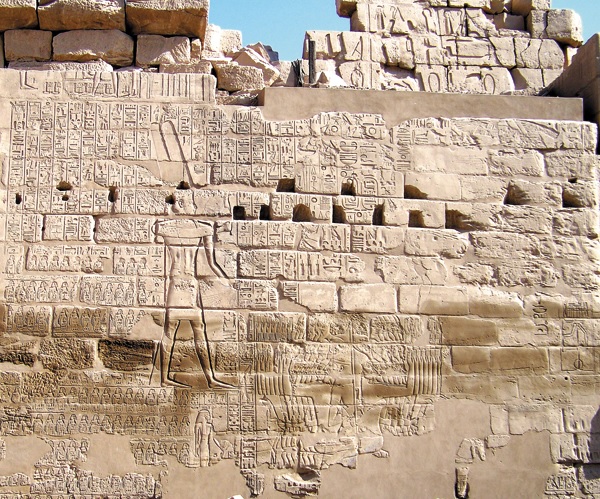
f
Egyptologists identified Shishak with Shoshenq I. Shoshenq I left behind explicit records of a campaign into Canaan (scenes; a long list of Canaanite place-names from the Negev to Galilee; stelae), including a stela [found] at Megiddo. There is a detailed list of cities in the regions of Syria, Philistia, Phoenicia, the Negev and the Kingdom of Israel inscribed on the walls of temples of Amun at al-Hibah and Karnak.
I KINGS 15:18-20 ~ So Asa took silver and gold from the treasuries of the Lord’s temple and the king’s palace. He gave the silver and gold to his servants and sent them to Ben Hadad, the king of Aram. Ben Hadad was the of Hezion. Damascus was Ben Hadad’s capital city. Asa sent this message, “My father and your father had a peace agreement. Now I want to make a peace agreement with you. I am sending you this gift of gold and silver. Please break your treaty with Baasha the king of Israel so he will get out of my country and leave us alone.” King Ben Hadad made that agreement with King Asa and sent his army to fight against the Israelite towns of Ijon, Dan, Abel Beth Maacah, the towns near Lake Galilee, and the area of Naphtali. = الملوك الأول الفصل 15
18 وَأَخَذَ آسَا جَمِيعَ الْفِضَّةِ وَالذَّهَبِ الْبَاقِيَةِ فِي خَزَائِنِ بَيْتِ الرَّبِّ وَخَزَائِنِ بَيْتِ الْمَلِكِ وَدَفَعَهَا لِيَدِ عَبِيدِهِ، وَأَرْسَلَهُمُ الْمَلِكُ آسَا إِلَى بَنْهَدَدَ بْنِ طَبْرِيمُونَ بْنِ حَزْيُونَ مَلِكِ أَرَامَ السَّاكِنِ فِي دِمَشْقَ قَائِلاً:
19 [إِنَّ بَيْنِي وَبَيْنَكَ وَبَيْنَ أَبِي وَأَبِيكَ عَهْداً. هُوَذَا قَدْ أَرْسَلْتُ لَكَ هَدِيَّةً مِنْ فِضَّةٍ وَذَهَبٍ، فَتَعَالَ انْقُضْ عَهْدَكَ مَعَ بَعْشَا مَلِكِ إِسْرَائِيلَ فَيَصْعَدَ عَنِّي].
20 فَسَمِعَ بَنْهَدَدُ لِلْمَلِكِ آسَا وَأَرْسَلَ رُؤَسَاءَ الْجُيُوشِ الَّتِي لَهُ عَلَى مُدُنِ إِسْرَائِيلَ، وَضَرَبَ عُيُونَ وَدَانَ وَآبَلَ بَيْتِ مَعْكَةَ وَكُلَّ كِنَّرُوتَ مَعَ كُلِّ أَرْضِ نَفْتَالِي.
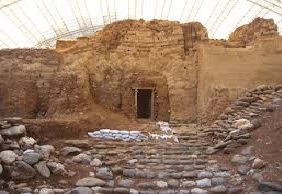
Lower-half of gate into Tel-Dan
In 1994, two more fragments from the inscription were found at Tel-Dan. The following is a translation of the text that was found written in the early Aramaic language, similar to script found on pottery dating back to the ninth century B.C. In this translation, the letters found in brackets represents a suggested reconstruction of what the words may have been.
… my father went forward … he made battle at … and he died, he went to … king of [Is-] rael of old was in my fathers land…Hadad appointed me king. And Hadad went before me … I embarked from seven….. of my kingdom… And I killed ……kin[gs] …. [cha-] riots and horsemen numbering two thousand…[He (or I) killed Jeho]ram (Joram) son of [Ahab]. the king of Israel. [He (or I)] killed [Ahaz] iahu son of [Jehoram kin-] g of the House of David. And I turned their country into… other […Jehu ru-] led over Is[rael] siege upon…
I KINGS 18:40 ~ Then Elijah said, “Get the prophets of Baal! Don’t let any of them escape!” So the people captured all the prophets. Then Elijah led them down to Kishon Creek. At that place he killed all the prophets. = الملوك الأول الفصل 18
40 فَقَالَ لَهُمْ إِيلِيَّا: [أَمْسِكُوا أَنْبِيَاءَ الْبَعْلِ وَلاَ يُفْلِتْ مِنْهُمْ رَجُلٌ]. فَأَمْسَكُوهُمْ، فَنَزَلَ بِهِمْ إِيلِيَّا إِلَى نَهْرِ قِيشُونَ وَذَبَحَهُمْ هُنَاكَ.
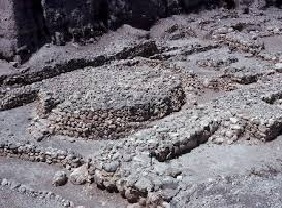
Altar in temple of Ashtoroth in Megiddo
The Oriental Institute excavating Megiddo near Samaria found in the stratum of King Ahab’s time the ruins of a temple of Ashtoreth, goddess wife of Baal. Their temples usually were not far apart. Just a few steps from this was a cemetery where many jars were found containing the remains of infants who had been sacrificed in the temple. This shows the nature of Baal worship. Prophets of Baal and Ashtoreth were official murderers of little children.
I KINGS 19:15 ~ The Lord said, “Go back on the road that leads to the desert around Damascus. Go into Damascus, and anoint Hazael as king over Aram. = الملوك الأول الفصل 19
15 فَقَالَ لَهُ الرَّبُّ: [اذْهَبْ رَاجِعاً فِي طَرِيقِكَ إِلَى بَرِّيَّةِ دِمِشْقَ، وَادْخُلْ وَامْسَحْ حَزَائِيلَ مَلِكاً عَلَى أَرَامَ،
King Hazael (841-806 BC) was king of Aram (Syria) after Ben-Hadad II. An ivory inlay fragment found at Arslan Tash refers to “My Lord Hazael“.

An inscription on a statue of him reads, “Barhadad, son of Hazael“. This ivory statuette came from the palace of Hazael the ancient king of Damascus. It was discovered in the ruins of Arslan Tash in north Syria (ancient Hadatu). Several artifacts from the palace of Hazael are now in the Aleppo Museum in Syria.
In 1994, two more fragments from the inscription were found at Tel-Dan. The entire inscription is above. Note line three, “Hadad appointed me king” and line four “Hadad went before me.”
I KINGS 21:8 ~ Then Jezebel wrote some letters. She signed Ahab’s name to the letters. She used Ahab’s own seal to seal the letters. Then she sent them to the elders (leaders) and important men who lived in the same town as Naboth. = الملوك الأول الفصل 21
8 ثُمَّ كَتَبَتْ رَسَائِلَ بِاسْمِ أَخْآبَ وَخَتَمَتْهَا بِخَاتِمِهِ، وَأَرْسَلَتِ الرَّسَائِلَ إِلَى الشُّيُوخِ وَالأَشْرَافِ الَّذِينَ فِي مَدِينَتِهِ السَّاكِنِينَ مَعَ نَابُوتَ.

The seal of Jezebel is in the Israel Antiquities Authority Collection, exhibited at the Israel Museum, Jerusalem.
I KINGS 22:39 ~ All the things that King Ahab did during the time he ruled are written in the book The History of the Kings of Israel. And that book also tells about the ivory that the king used to make his palace more beautiful. And the book tells about the city that the king built. = الملوك الأول الفصل 22
39 وَبَقِيَّةُ أُمُورِ أَخْآبَ وَكُلُّ مَا فَعَلَ، وَبَيْتُ الْعَاجِ الَّذِي بَنَاهُ وَكُلُّ الْمُدُنِ الَّتِي بَنَاهَا مَكْتُوبَةٌ فِي سِفْرِ أَخْبَارِ الأَيَّامِ لِمُلُوكِ إِسْرَائِيلَ.
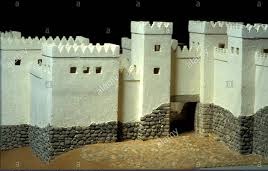
All that remains of King Ahab’s ivory palace is the lower walls
An inscription of Shalmaneser (860-835 BC) mentions Ahab: “At Karkar I destroyed…2,000 chariots and 10,000 men of Ahab, king of Israel.” in this record of the Battle of Karkar (853 BC). Shalmaneser III of Assyria memorialized the battle in an inscription in which he described his adversaries as a major confederation of princes under Hadadezer (Ben-Hadad) of Syria. “Ahab the Israelite” is named as one of Shalmaneser’s enemies.
An expedition by Harvard University found in Samaria the ruins of Ahab’s ivory house. Its walls had been faced with ivory. There were thousands of pieces of the most exquisitely carved and inlaid panels, plaques, cabinets and couches. Ahab’s house was just above the ruins of Omri’s palace.
5 وَعِنْدَ مَوْتِ أَخْآبَ عَصَى مَلِكُ مُوآبَ عَلَى مَلِكِ إِسْرَائِيلَ.
6 وَخَرَجَ الْمَلِكُ يُورَامُ فِي ذَلِكَ الْيَوْمِ مِنَ السَّامِرَةِ وَعَدَّ كُلَّ إِسْرَائِيلَ،
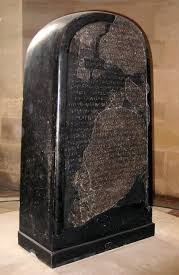
Moabite Stone at the Louvre.
Mesha, king of Moab made his own record of this rebellion. That record has been found and is called the “Moabite Stone.” It was found in 1868 in Moab at Dibon, 20 miles east of the Dead Sea, by F. A.Klein. It is a bluish basalt stone 4’ high, 2’ wide, and 14” thick. It is now in the Louvre Museum in Paris.
“I, Mesha, king of Moab, made this monument to Chemosh [god of Moab] to commemorate deliverance from Israel. My father reigned over Moab 30 years and I reigned after my father. Omri, king of Israel, oppressed Moab many days, and his son [Ahab] after him. But I warred against the king of Israel and drove him out, and took his cities Medeba, Ataroth, Nebo and Jahaz which he built while he waged war against me. I destroyed his cities and devoted the spoils to Chemosh and the women and girls to Ashtar. I built Qorhah with prisoners from Israel. In Beth-Diblathaim I placed sheep raisers.’
II KINGS 8:7-15 ~ Elisha went to Damascus. Ben Hadad king of Aram was sick. A person told Ben Hadad, “The man of God* has come here.” Then the King Ben Hadad said to Hazael, “Take a gift, and go to meet the man of God…..Hazael went to Elisha. Hazael said, “Your follower, Ben Hadad king of Aram, sent me to you. …. Elisha answered, “I am crying because I know the bad things you will do to the Israelites. You will burn their strong cities. You will kill their young men with swords. You will kill their babies. You will split open their pregnant women.” Hazael said, I am not a powerful man! I
can’t do these great things!” Elisha answered, “The Lord showed me that you will be king over Aram.” Then Hazael left Elisha, and went to his king. But the next day, Hazael took a thick cloth and dipped it in water. Then he put the cover on Ben Hadad’s face {and smothered him}. Ben Hadad died and Hazael became the new king = لملوك الثاني الفصل 8
7 وَجَاءَ أَلِيشَعُ إِلَى دِمَشْقَ. وَكَانَ بَنْهَدَدُ مَلِكُ أَرَامَ مَرِيضاً، فَقِيلَ لَهُ: [قَدْ جَاءَ رَجُلُ اللَّهِ إِلَى هُنَا].
8 فَقَالَ الْمَلِكُ لِحَزَائِيلَ: [خُذْ بِيَدِكَ هَدِيَّةً وَاذْهَبْ لاِسْتِقْبَالِ رَجُلِ اللَّهِ، وَاسْأَلِ الرَّبَّ بِهِ: هَلْ أَشْفَى مِنْ مَرَضِي هَذَا].
9 فَذَهَبَ حَزَائِيلُ لاِسْتِقْبَالِهِ وَأَخَذَ هَدِيَّةً بِيَدِهِ، وَمِنْ كُلِّ خَيْرَاتِ دِمَشْقَ حِمْلَ أَرْبَعِينَ جَمَلاً وَجَاءَ وَوَقَفَ أَمَامَهُ وَقَالَ: [إِنَّ ابْنَكَ بَنْهَدَدَ مَلِكَ أَرَامَ قَدْ أَرْسَلَنِي إِلَيْكَ قَائِلاً: هَلْ أُشْفَى مِنْ مَرَضِي هَذَا؟]
10 فَقَالَ لَهُ أَلِيشَعُ: [اذْهَبْ وَقُلْ لَهُ شِفَاءً تُشْفَى. وَقَدْ أَرَانِي الرَّبُّ أَنَّهُ يَمُوتُ مَوْتاً].
11 فَجَعَلَ نَظَرَهُ عَلَيْهِ وَثَبَّتَهُ حَتَّى خَجِلَ. فَبَكَى رَجُلُ اللَّهِ.
12 فَقَالَ حَزَائِيلُ: [لِمَاذَا يَبْكِي سَيِّدِي؟] فَقَالَ: [لأَنِّي عَلِمْتُ مَا سَتَفْعَلُهُ بِبَنِي إِسْرَائِيلَ مِنَ الشَّرِّ، فَإِنَّكَ تُطْلِقُ النَّارَ فِي حُصُونِهِمْ وَتَقْتُلُ شُبَّانَهُمْ بِالسَّيْفِ وَتُحَطِّمُ أَطْفَالَهُمْ وَتَشُقُّ حَوَامِلَهُمْ].
13 فَقَالَ حَزَائِيلُ: [وَمَنْ هُوَ عَبْدُكَ الْكَلْبُ حَتَّى يَفْعَلَ هَذَا الأَمْرَ الْعَظِيمَ؟] فَقَالَ أَلِيشَعُ: [قَدْ أَرَانِي الرَّبُّ إِيَّاكَ مَلِكاً عَلَى أَرَامَ].
14 فَانْطَلَقَ مِنْ عِنْدِ أَلِيشَعَ وَدَخَلَ إِلَى سَيِّدِهِ فَسَأَلَهُ: [مَاذَا قَالَ لَكَ أَلِيشَعُ؟] فَقَالَ: [قَالَ لِي إِنَّكَ تَحْيَا].
15 وَفِي الْغَدِ أَخَذَ اللِّبْدَةَ وَغَمَسَهَا بِالْمَاءِ وَنَشَرَهَا عَلَى وَجْهِهِ وَمَاتَ، وَمَلَكَ حَزَائِيلُ عِوَضاً عَنْهُ.
II KINGS 9:15 ~ King Joram had fought against Hazael, king of Aram. = لملوك الثاني الفصل 9
15 وَرَجَعَ يُورَامُ الْمَلِكُ لِيَبْرَأَ فِي يَزْرَعِيلَ مِنَ الْجُرُوحِ الَّتِي ضَرَبَهُ بِهَا الأَرَامِيُّونَ حِينَ قَاتَلَ حَزَائِيلَ مَلِكَ أَرَامَ. فَقَالَ
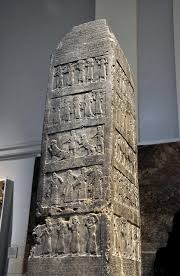
referring to BEN HADAD & HAZAEL
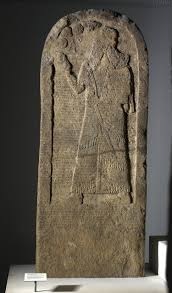
SHALMANESER III, King of
Assyria
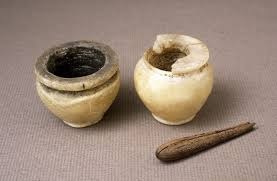
I KINGS 16:31 ~ King…Ahab also married Jezebel daughter of Ethbaal. = لملوك الأول الفصل 16
31 وَكَأَنَّهُ كَانَ أَمْراً زَهِيداً سُلُوكُهُ فِي خَطَايَا يَرُبْعَامَ بْنِ نَبَاطَ حَتَّى اتَّخَذَ إِيزَابَلَ ابْنَةَ أَثْبَعَلَ مَلِكِ الصَّيْدُونِيِّينَ امْرَأَةً، وَعَبَدَ الْبَعْلَ وَسَجَدَ لَهُ.
An expedition sponsored by Harvard University, the Hebrew University of Jerusalem, the British School of Archaeology, and the Palestine Exploration Fund found in Samaria in the ruins of Ahab’s “ivory house” the very saucers, small stone boxes, in which Jezebel mixed her cosmetics. They had a number of small holes to contain the various colors ~ kohl for black; turquoise for green; ochre for red ~ and a central depression for mixing. They still had traces of red.
II KINGS 10:34-36 ~ All the other great things that Jehu did are written in the book The History of the Kings of Israel…. Jehu’s son Jehoahaz became the new king of Israel after him. Jehu ruled over Israel in Samaria for 28 years = لملوك الثاني الفصل 10
34 وَبَقِيَّةُ أُمُورِ يَاهُو وَكُلُّ مَا عَمَلَ وَكُلُّ جَبَرُوتِهِ مَكْتُوبَةٌ فِي سِفْرِ أَخْبَارِ الأَيَّامِ لِمُلُوكِ إِسْرَائِيلَ.
35 وَاضْطَجَعَ يَاهُو مَعَ آبَائِهِ فَدَفَنُوهُ فِي السَّامِرَةِ، وَمَلَكَ يَهُوأَحَازُ ابْنُهُ عِوَضاً عَنْهُ.
36 وَكَانَتِ الأَيَّامُ الَّتِي مَلَكَ فِيهَا يَاهُو عَلَى إِسْرَائِيلَ فِي السَّامِرَةِ ثَمَانِياً وَعِشْرِينَ سَنَةً.
Jehu appeared in Assyrian documents, notably in the Black Obelisk, where he was depicted as kissing the ground in front of Shalmaneser III. In the Assyrian documents he was simply referred to as “Jehu son of Omri” (The House of Omri ~ the Kingdom of Israel). This tribute is dated 841 BC. According to the Obelisk, Jehu became subject to Assyria.
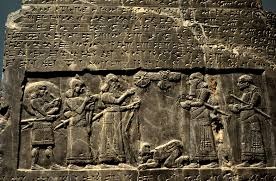
II KINGS 14:23 ~ Jeroboam son of Jehoash king of Israel began to rule in Samaria during the 15th year that Amaziah son of Joash was king of Judah. Jeroboam ruled 41 years. = لملوك الثاني الفصل 14
23 فِي السَّنَةِ الْخَامِسَةَ عَشَرَةَ لأَمَصْيَا بْنِ يَهُوآشَ مَلِكِ يَهُوذَا، مَلَكَ يَرُبْعَامُ بْنُ يُوآشَ مَلِكِ إِسْرَائِيلَ فِي السَّامِرَةِ إِحْدَى وَأَرْبَعِينَ سَنَةً.
At the ruins of Megiddo, a jasper seal was found with the following inscription:
“Shema servant of Jeroboam”

Jereboam Seal
II KINGS 15:19-20 ~ Pul king of Assyria came to fight against Israel. Menahem gave Pul 75,000 pounds of silver. He did this so Pul would support Menahem and make Menahem’s kingdom stronger. Menahem raised the money by making all the rich and powerful men pay taxes. Menahem taxed each man 20 ounces of silver. Then Menahem gave the money to the king of Assyria. So the king of Assyria left, and did not stay there in Israel. = لملوك الثاني الفصل 15
19 فَجَاءَ فُولُ مَلِكُ أَشُّورَ عَلَى الأَرْضِ، فَأَعْطَى مَنَحِيمُ لِفُولَ أَلْفَ وَزْنَةٍ مِنَ الْفِضَّةِ لِتَكُونَ يَدَاهُ مَعَهُ لِيُثَبِّتَ الْمَمْلَكَةَ فِي يَدِهِ.
20 وَوَضَعَ مَنَحِيمُ الْفِضَّةَ عَلَى إِسْرَائِيلَ عَلَى جَمِيعِ جَبَابِرَةِ الْبَأْسِ لِيَدْفَعَ لِمَلِكِ أَشُّورَ خَمْسِينَ شَاقِلَ فِضَّةٍ عَلَى كُلِّ رَجُلٍ. فَرَجَعَ مَلِكُ أَشُّورَ وَلَمْ يُقِمْ هُنَاكَ فِي الأَرْضِ.
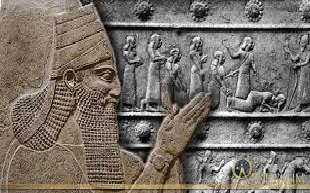
Tiglath-Pileser III on wall of his palace
II KINGS 15:29 ~ Tiglath Pileser king of Assyria came to fight against Israel. This was during the time that Pekah was king of Israel. Tiglath Pileser captured Ijon, Abel Bethmaacah, Janoah, Kedesh, Hazor, Gilead, Galilee, and all the area of Naphtali. Tiglath Pileser took the people from these places as prisoners to Assyria. Hoshea son of Elah made plans against Pekah son of Remaliah. Hoshea killed Pekah. Then Hoshea became the new king after Pekah. This was during the 20th year that Jotham son of Uzziah {was king of Judah}. = لملوك الثاني الفصل 15
29 فِي أَيَّامِ فَقْحٍ مَلِكِ إِسْرَائِيلَ، جَاءَ تَغْلَثَ فَلاَسِرُ مَلِكُ أَشُّورَ وَأَخَذَ عُيُونَ وَآبَلَ بَيْتِ مَعْكَةَ وَيَانُوحَ وَقَادِشَ وَحَاصُورَ وَجِلْعَادَ وَالْجَلِيلَ وَكُلَّ أَرْضِ نَفْتَالِي، وَسَبَاهُمْ إِلَى أَشُّورَ.
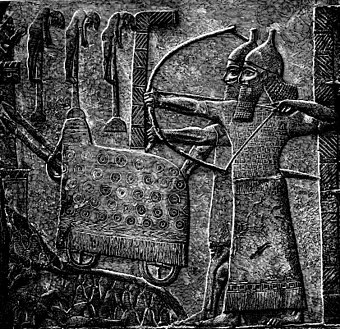
An inscription on a wall in Tiglath-Pileser‘s palace in Nimrod says, “Pekah their king they had overthrown. I placed Hoshea over them. From him I received 10 talents of gold and 1000 talents of silver.”
The scribes of the Tiglath-Pileser III wrote the annuals (numbering 1 to 17) upon reliefs of each hall in the palace of Tiglath-Pileser III in Calah (also known as Nimrod), the Assyrian capital at that time. Relief slabs carried the standard Inscription which contained the details of the king’s military achievements. These slabs were arranged in chronological order.
II KINGS 17:1,3 – Hoshea son of Elah began to rule in Samaria over Israel….Shalmaneser king of Assyria came to fight against Hoshea. {Shalmaneser defeated Hoshea} and Hoshea became his servant. So Hoshea paid tribute to Shalmaneser. = لملوك الثاني الفصل 17
1 فِي السَّنَةِ الثَّانِيَةَ عَشَرَةَ لآحَازَ مَلِكِ يَهُوذَا، مَلَكَ هُوشَعُ بْنُ أَيْلَةَ فِي السَّامِرَةِ عَلَى إِسْرَائِيلَ تِسْعَ سِنِينَ.
3 وَصَعِدَ عَلَيْهِ شَلْمَنْأَسَرُ مَلِكُ أَشُّورَ فَصَارَ لَهُ هُوشَعُ عَبْداً وَدَفَعَ لَهُ جِزْيَةً.
This Shalmaneser V was the son of Tiglath-Pileser III and only reigned five years
All important people had seals so letters would be honored as genuine. Such a seal has been found inscribed with this: Abdi, Servant of Hoshea.
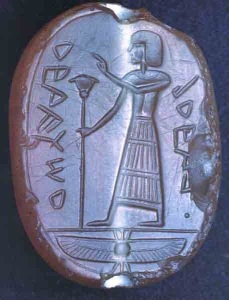
Seal of Abdi, Servant of Hoshea
II KINGS 17:5-6, 24 ~ The king of Assyria [Sargon] attacked many places in Israel. T = hen he came to Samaria. He fought against Samaria for three years. The king of Assyria took Samaria during the ninth year that Hoshea was king of Israel. The king of Assyria captured many Israelites and took them as prisoners to Assyria. He made them live in Halah by the Habor River at Gozan and in other cities of the Medes….{The king of Assyria took the Israelites out of Samaria.} Then the king of Assyria brought people from Babylon, Cuthah, Avva, Hamath, and Sepharvaim. He put those people
in Samaria. Those people took over Samaria and lived in the cities around it. = لملوك الثاني الفصل 17
5 وَصَعِدَ مَلِكُ أَشُّورَ عَلَى كُلِّ الأَرْضِ، وَصَعِدَ إِلَى السَّامِرَةِ وَحَاصَرَهَا ثَلاَثَ سِنِينَ.
6 فِي السَّنَةِ التَّاسِعَةِ لِهُوشَعَ أَخَذَ مَلِكُ أَشُّورَ السَّامِرَةَ، وَسَبَى إِسْرَائِيلَ إِلَى أَشُّورَ وَأَسْكَنَهُمْ فِي حَلَحَ وَخَابُورَ نَهْرِ جُوزَانَ وَفِي مُدُنِ مَادِي.
24 وَأَتَى مَلِكُ أَشُّورَ بِقَوْمٍ مِنْ بَابِلَ وَكُوثَ وَعَوَّا وَحَمَاةَ وَسَفَرْوَايِمَ وَأَسْكَنَهُمْ فِي مُدُنِ السَّامِرَةِ عِوَضاً عَنْ بَنِي إِسْرَائِيلَ، فَامْتَلَكُوا السَّامِرَةَ وَسَكَنُوا فِي مُدُنِهَا.

Sargon II, Antiquities of Iraq
An inscription of Sargon II in his palace ruins says, “In my first year I captured Samaria. I took captive 27,290 people. People of other lands who never paid tribute I settled in Samaria.”
Sargon II became co-regent with Shalmaneser V in 722 BC and became the sole ruler of the kingdom of Assyria that same year after the death of Shalmaneser V. Shalmaneser V only reigned 5 years. He may have had a co-regent because of illness.
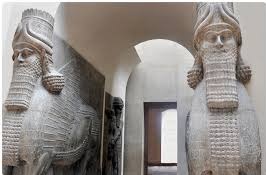
Winled human-headed bulls at palace gates of Khorisbad. Now at University of Chicago.
II KINGS 17:1, 21 ~ Hoshea son of Elah began to rule in Samaria over Israel (northern half of what used to be David’s kingdom). This was during the 12th year that Ahaz was king of Judah (southern half of all that was left of David’s kingdom)….The Lord tore Israel from the family of David [Judah in the south], and the Israelites [Israel in the north] made Jeroboam son of Nebat their king. = لملوك الثاني الفصل 1
1 فِي السَّنَةِ الثَّانِيَةَ عَشَرَةَ لآحَازَ مَلِكِ يَهُوذَا، مَلَكَ هُوشَعُ بْنُ أَيْلَةَ فِي السَّامِرَةِ عَلَى إِسْرَائِيلَ تِسْعَ سِنِينَ.
21 لأَنَّهُ شَقَّ إِسْرَائِيلَ عَنْ بَيْتِ دَاوُدَ، فَمَلَّكُوا يَرُبْعَامَ بْنَ نَبَاطَ، فَأَبْعَدَ يَرُبْعَامُ إِسْرَائِيلَ مِنْ وَرَاءِ الرَّبِّ وَجَعَلَهُمْ يُخْطِئُونَ خَطِيَّةً عَظِيمَةً.
Lines 7 & 8 of the Tel Dan stone states (see above) that Israel was a divided kingdom, because it mentions the “King of Israel” and the king of the “House of David” [Judah in the south].
II KINGS 18:9-10 ~ Shalmaneser king of Assyria went to fight against Samaria. His army surrounded the city….(This was also the seventh year that Hoshea son of Elah was king of Israel.) At the end of the third year, Shalmaneser captured Samaria….(This was also the ninth year that Hoshea was king of Israel.) = لملوك الثاني الفصل 18
9 وَفِي السَّنَةِ الرَّابِعَةِ لِلْمَلِكِ حَزَقِيَّا، وَهِيَ السَّنَةُ السَّابِعَةُ لِهُوشَعَ بْنِ أَيْلَةَ مَلِكِ إِسْرَائِيلَ، صَعِدَ شَلْمَنْأَسَرُ مَلِكُ أَشُّورَ عَلَى السَّامِرَةِ وَحَاصَرَهَا.
10 وَأَخَذُوهَا فِي نِهَايَةِ ثَلاَثِ سِنِينَ. فَفِي السَّنَةِ السَّادِسَةِ لِحَزَقِيَّا، وَهِيَ السَّنَةُ التَّاسِعَةُ لِهُوشَعَ مَلِكِ إِسْرَائِيلَ، أُخِذَتِ السَّامِرَةُ.
The “Black Obelisk” pictured above was located at Calah, near Nineveh in today’s Iraq by
Archaeologist Layard in the palace of Shalmaneser. It is a block of hard black stone 7 feet high, covered with reliefs and inscriptions depicting his exploits. It is now in the British Museum. On the second line from the top is a figure with Jewish features kneeling at the feet of the king. Above it is this inscription:
“The tribute of Joshea [Hoshea], son [successor] of Omri, silver, gold, bowls of gold, chalices of gold, cups of gold, vases of gold, lead, sceptre for the king, and spear shafts I have received.”
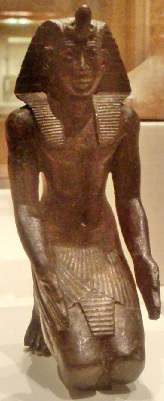
Pharaoh Neco, Brooklyn Museum
II KINGS 23:29-30 ~ During Josiah’s time, Pharaoh Neco, the king of Egypt went to fight against the king of Assyria at the Euphrates River. Josiah went out to meet Neco at Megiddo. Pharaoh saw Josiah and killed him. = لملوك الثاني الفصل 23
29 فِي أَيَّامِهِ صَعِدَ فِرْعَوْنُ نَخُو مَلِكُ مِصْرَ عَلَى مَلِكِ أَشُّورَ إِلَى نَهْرِ الْفُرَاتِ. فَصَعِدَ الْمَلِكُ يُوشِيَّا لِلِقَائِهِ، فَقَتَلَهُ فِي مَجِدُّو حِينَ رَآهُ.
30 وَأَرْكَبَهُ عَبِيدُهُ مَيِّتاً مِنْ مَجِدُّو وَجَاءُوا بِهِ إِلَى أُورُشَلِيمَ وَدَفَنُوهُ فِي قَبْرِهِ. فَأَخَذَ شَعْبُ الأَرْضِ يَهُوآحَازَ بْنَ يُوشِيَّا وَمَسَحُوهُ وَمَلَّكُوهُ عِوَضاً عَنْ أَبِيهِ.
In the spring of 609 BC, Pharaoh Necho personally led a sizable force to help the Assyrians. Josiah of Judah sided with the Babylonians and attempted to block his advance at Megiddo, where a fierce battle was fought and Josiah was killed
II KINGS 23:30, 32-35 ~ Then the common people took Josiah’s son Jehoahaz and anointed him. They made Jehoahaz the new king….Pharaoh Neco put Jehoahaz in prison….made Josiah’s son Eliakim the new king. Eliakim took the place of Josiah his father. Pharaoh Neco changed Eliakim’s name to Jehoiakim. And Pharaoh Neco took Jehoahaz away to Egypt. Jehoahaz died in Egypt. Jehoiakim gave the silver and the gold to Pharaoh. = لملوك الثاني الفصل 23
30 وَأَرْكَبَهُ عَبِيدُهُ مَيِّتاً مِنْ مَجِدُّو وَجَاءُوا بِهِ إِلَى أُورُشَلِيمَ وَدَفَنُوهُ فِي قَبْرِهِ. فَأَخَذَ شَعْبُ الأَرْضِ يَهُوآحَازَ بْنَ يُوشِيَّا وَمَسَحُوهُ وَمَلَّكُوهُ عِوَضاً عَنْ أَبِيهِ.
32 فَعَمِلَ الشَّرَّ فِي عَيْنَيِ الرَّبِّ حَسَبَ كُلِّ مَا عَمِلَهُ آبَاؤُهُ.
33 وَأَسَرَهُ فِرْعَوْنُ نَخُو فِي رَبْلَةَ فِي أَرْضِ حَمَاةَ لِئَلاَّ يَمْلِكَ فِي أُورُشَلِيمَ، وَغَرَّمَ الأَرْضَ بِمِئَةِ وَزْنَةٍ مِنَ الْفِضَّةِ وَوَزْنَةٍ مِنَ الذَّهَبِ.
34 وَمَلَّكَ فِرْعَوْنُ نَخُو أَلِيَاقِيمَ بْنَ يُوشِيَّا عِوَضاً عَنْ يُوشِيَّا أَبِيهِ، وَغَيَّرَ اسْمَهُ إِلَى يَهُويَاقِيمَ، وَأَخَذَ يَهُوآحَازَ وَجَاءَ إِلَى مِصْرَ فَمَاتَ هُنَاكَ.
35 وَدَفَعَ يَهُويَاقِيمُ الْفِضَّةَ وَالذَّهَبَ لِفِرْعَوْنَ، إِلاَّ أَنَّهُ قَوَّمَ الأَرْضَ لِدَفْعِ الْفِضَّةِ بِأَمْرِ فِرْعَوْنَ. كُلَّ وَاحِدٍ حَسَبَ تَقْوِيمِهِ. فَطَالَبَ شَعْبَ الأَرْضِ بِالْفِضَّةِ وَالذَّهَبِ لِيَدْفَعَ لِفِرْعَوْنَ نَخُو.
Pharaoh Necho continued forward, crossed the Euphrates and laid siege to Harran. Leaving a sizable force behind, Necho returned to Egypt. On his return march, he found that the Judeans had selected Jehoahaz to succeed his father Josiah. Necho deposed him, and replaced with Jehoiakim. He brought Jehoahaz back to Egypt as his prisoner, where Jehoahaz ended his days.
II KINGS 24:8 ~Jehoiachin was 18 years old when he began to rule. He ruled three months in Jerusalem. = لملوك الثاني الفصل 24
8 كَانَ يَهُويَاكِينُ ابْنَ ثَمَانِي عَشَرَةَ سَنَةً حِينَ مَلَكَ، وَمَلَكَ ثَلاَثَةَ أَشْهُرٍ فِي أُورُشَلِيمَ. وَاسْمُ أُمِّهِ نَحُوشْتَا بِنْتُ أَلْنَاثَانَ مِنْ أُورُشَلِيمَ.
Inscriptions have been discovered on three pottery jar handles, apparently to remind the servants not to take them home for private use. They were inscribed with these words: “Eliakim officer Yaukin”. Yaukin is the Aramaic name for Jehoiachin. Eliakim was King Yaukin’s/Jehoiachin/s officer.
II KINGS 24:9-12,15,17 ~ At that time, the officers of Nebuchadnezzar king of Babylon came to Jerusalem and surrounded it. Then Nebuchadnezzar king of Babylon came to the city. Jehoiachin king of Judah went out to meet the king of Babylon….Then the king of Babylon captured Jehoiachin. This was during the eighth year of Nebuchadnezzar’s rule….Nebuchadnezzar took Jehoiachin to Babylon as prisoner….The king of Babylon made Mattaniah the new king.
Mattaniah was Jehoiachin’s uncle. He changed his name to Zedekiah. = لملوك الثاني الفصل 24
9 وَعَمِلَ الشَّرَّ فِي عَيْنَيِ الرَّبِّ حَسَبَ كُلِّ مَا عَمِلَ أَبُوهُ.
10 فِي ذَلِكَ الزَّمَانِ صَعِدَ عَبِيدُ نَبُوخَذْنَصَّرَ مَلِكِ بَابِلَ إِلَى أُورُشَلِيمَ، فَدَخَلَتِ الْمَدِينَةُ تَحْتَ الْحِصَارِ.
11 وَجَاءَ نَبُوخَذْنَصَّرُ مَلِكُ بَابِلَ عَلَى الْمَدِينَةِ وَكَانَ عَبِيدُهُ يُحَاصِرُونَهَا.
12 فَخَرَجَ يَهُويَاكِينُ مَلِكُ يَهُوذَا إِلَى مَلِكِ بَابِلَ هُوَ وَأُمُّهُ وَعَبِيدُهُ وَرُؤَسَاؤُهُ وَخِصْيَانُهُ، وَأَخَذَهُ مَلِكُ بَابِلَ فِي السَّنَةِ الثَّامِنَةِ مِنْ مُلْكِهِ.
15 وَسَبَى يَهُويَاكِينَ إِلَى بَابِلَ. وَأُمَّ الْمَلِكِ وَنِسَاءَ الْمَلِكِ وَخِصْيَانَهُ وَأَقْوِيَاءَ الأَرْضِ سَبَاهُمْ مِنْ أُورُشَلِيمَ إِلَى بَابِلَ.
17 وَمَلَّكَ مَلِكُ بَابِلَ مَتَّنِيَّا عَمَّهُ عِوَضاً عَنْهُ، وَغَيَّرَ اسْمَهُ إِلَى صِدْقِيَّا.
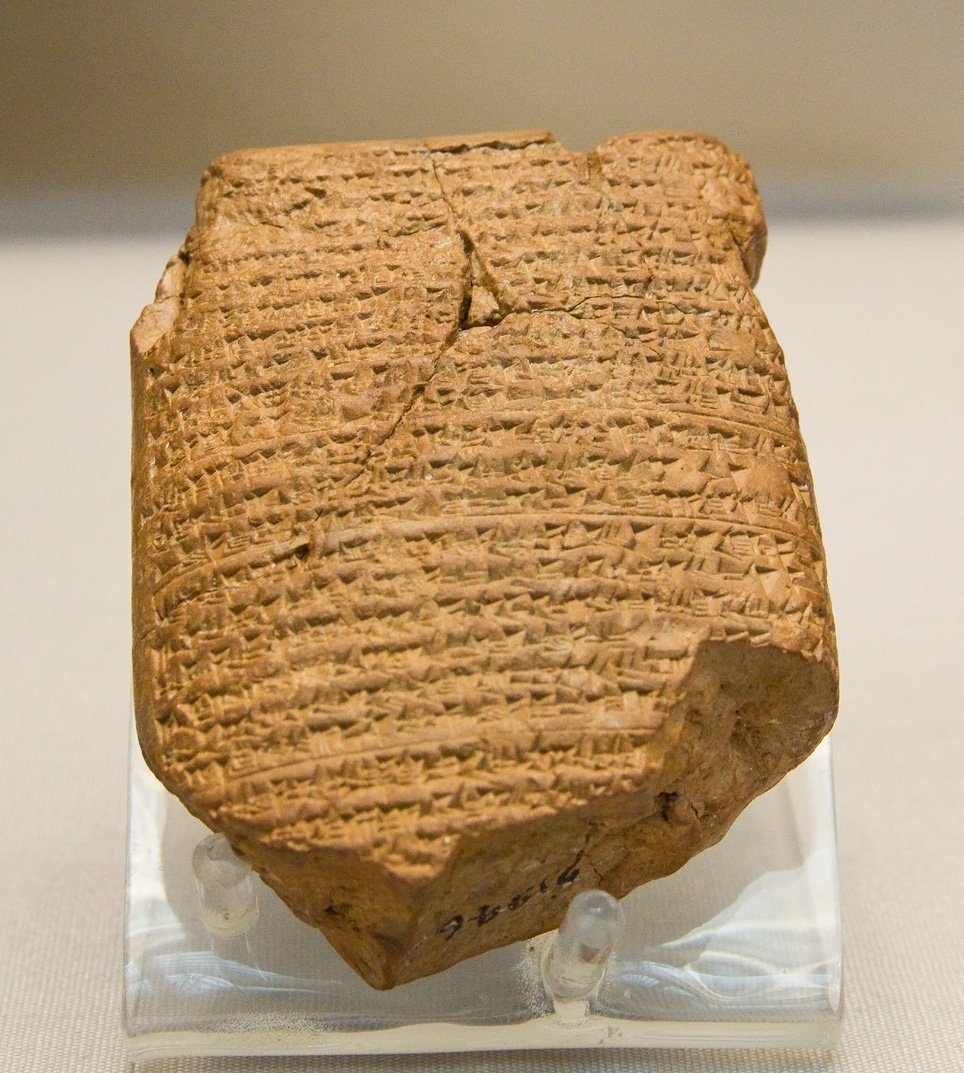
Babylonian Chronicle in British Museum
The clay tablet known as the Babylonian Chronicle records events from 605-594BC. It was first translated in 1956 and is now in the British Museum. The cuneiform text on this clay tablet tells of many things in the life of Nebuchadnezzar who had conquered Assyria, then went out to conquer Egypt and the rest of the Middle East. This is the account of his conquering Jerusalem and Judea:
“In the seventh month [of Nebuchadnezzar-599 BC] in the month Chislev [Nov/Dec] the king of Babylon assembled his army, and after he had invaded the land of Hatti (Syria/Palestine) he laid seige to the city [capitol] of Judah. On the second day of the month of Adara [16th of March] he conquered the city and took the king (Jehoiachin) prisoner. He installed in his place a king [Zedekiah] of his own choice, and after he had received rich tribute, he sent (them) forth to Babylon.”
II KINGS 24:17 ~ The king of Babylon made Mattaniah the new king. Mattaniah was Jehoiachin’s uncle. He changed his name to Zedekiah. = لملوك الثاني الفصل 24
17 وَمَلَّكَ مَلِكُ بَابِلَ مَتَّنِيَّا عَمَّهُ عِوَضاً عَنْهُ، وَغَيَّرَ اسْمَهُ إِلَى صِدْقِيَّا.
A collection of letters written on pottery was unearthed in the city of Lachish in Judea. These letters confirm events that occurred during King Zedekiah’s reign. One of the names mentioned was Mattaniah, Zedekiah’s birth name.
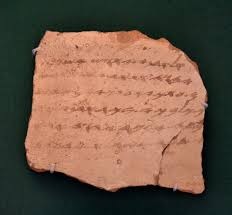
II KINGS 25:22-23 ~ Nebuchadnezzar made Gedaliah governor over those people in Judah. The army captains were….Jaazaniah son of the Maachathite. = لملوك الثاني الفصل 25
22 وَأَمَّا الشَّعْبُ الَّذِي بَقِيَ فِي أَرْضِ يَهُوذَا الَّذِينَ أَبْقَاهُمْ نَبُوخَذْنَصَّرُ مَلِكُ بَابِلَ، فَوَكَّلَ عَلَيْهِمْ جَدَلْيَا بْنَ أَخِيقَامَ بْنِ شَافَانَ.
23 وَلَمَّا سَمِعَ جَمِيعُ رُؤَسَاءِ الْجُيُوشِ هُمْ وَرِجَالُهُمْ أَنَّ مَلِكَ بَابِلَ قَدْ وَكَّلَ جَدَلْيَا أَتُوا إِلَى جَدَلْيَا إِلَى الْمِصْفَاةِ،
The name of Jaazaniah, one of the Judean military officers , was also found among the Lachish letters. “Further, a seal has been found bearing his name and inscribed: “Yaazenyahu (Jaazaniah), Servant of the King.”
II KINGS 25:27a ~ Later, Evil [Awil] Merodach [Marduk] became the king of Babylon. = لملوك الثاني الفصل 25
27 وَفِي السَّنَةِ السَّابِعَةِ وَالثَّلاَثِينَ لِسَبْيِ يَهُويَاكِينَ مَلِكِ يَهُوذَا، فِي الشَّهْرِ الثَّانِي عَشَرَ فِي السَّابِعِ وَالْعِشْرِينَ مِنَ الشَّهْرِ، رَفَعَ أَوِيلُ مَرُودَخُ مَلِكُ بَابِلَ فِي سَنَةِ تَمَلُّكِهِ رَأْسَ يَهُويَاكِينَ مَلِكِ يَهُوذَا مِنَ السِّجْنِ
Evil Merodach is the same as Awil Marduk. He reigned as king of Babylon 722-710 BC and again 703-702. This engraving is at the Berlin Museum.
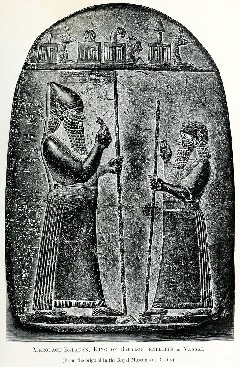
II KINGS 25:27b-30 ~ He let Jehoiachin king of Judah out of prison. This happened in the 37th year after Jehoiachin was captured. This was on the 27th day of the twelfth month from the time that Evil Merodach began to rule. Evil Merodach was kind to Jehoiachin. He gave Jehoiachin a more important place to sit than the other kings that were with him in Babylon. Evil Merodach let Jehoiachin stop wearing prison clothes. And Jehoiachin ate at the same table with Evil Merodach, every day for the rest of his life. So King Evil Merodach gave Jehoiachin every meal, every day, for the rest of his life. = لملوك الثاني الفصل 25
27 وَفِي السَّنَةِ السَّابِعَةِ وَالثَّلاَثِينَ لِسَبْيِ يَهُويَاكِينَ مَلِكِ يَهُوذَا، فِي الشَّهْرِ الثَّانِي عَشَرَ فِي السَّابِعِ وَالْعِشْرِينَ مِنَ الشَّهْرِ، رَفَعَ أَوِيلُ مَرُودَخُ مَلِكُ بَابِلَ فِي سَنَةِ تَمَلُّكِهِ رَأْسَ يَهُويَاكِينَ مَلِكِ يَهُوذَا مِنَ السِّجْنِ
28 وَكَلَّمَهُ بِخَيْرٍ، وَجَعَلَ كُرْسِيَّهُ فَوْقَ كَرَاسِيِّ الْمُلُوكِ الَّذِينَ مَعَهُ فِي بَابِلَ.
29 وَغَيَّرَ ثِيَابَ سِجْنِهِ. وَكَانَ يَأْكُلُ دَائِماً الْخُبْزَ أَمَامَهُ كُلَّ أَيَّامِ حَيَاتِهِ.
30 وَوَظِيفَتُهُ وَظِيفَةٌ دَائِمَةٌ تُعْطَى لَهُ مِنْ عِنْدِ الْمَلِكِ أَمْرُ كُلِّ يَوْمٍ بِيَوْمِهِ كُلَّ أَيَّامِ حَيَاتِهِ.
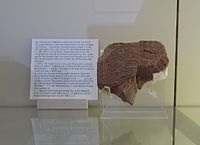
Tablets, now in Berlin museum, from the royal archives of the king of Babylon were found in the ruins of that city listing food rations paid to captives and craftsmen . On one of the tablets, “Yaukin, king of the land of Judah” is mentioned along with his five sons listed as royal princes. Below are a few inscriptions found on the tablets:
10 (sila of oil) to the king of Judah, Yaukin.
2 1/2 sila (oil) to the offspring of Judah’s king,
10 sila to Iakuukinu, the king of Judah’s son,
2 1/2 sila for the five sons of the Judean king
CHRONICLES
Chronicles starts over with a history of the kings.
5 وَقَالَ سُكَّانُ يَبُوسَ لِدَاوُدَ: «لاَ تَدْخُلْ إِلَى هُنَا». فَأَخَذَ دَاوُدُ حِصْنَ صِهْيَوْنَ (هِيَ مَدِينَةُ دَاوُدَ).
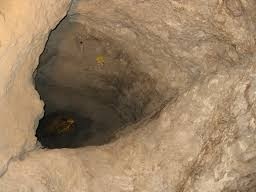
The watercourse that David’s men used to get inside the city of Jebus (which was later renamed Jerusalem) still exists. It is a sloping tunnel with steps cut down through solid rock from the top of the hill to Gihon Spring at the east base of the hill. This gave access within the walls to a water supply and to the city. The hill was surrounded by a wall 24 feet thick, impregnable until David discovered this secret passage from the spring into the city. It was discovered by archaeologist Warren, so today is called the Warren Shaft. Inside are steps leading up to the city from the Gihon Spring.
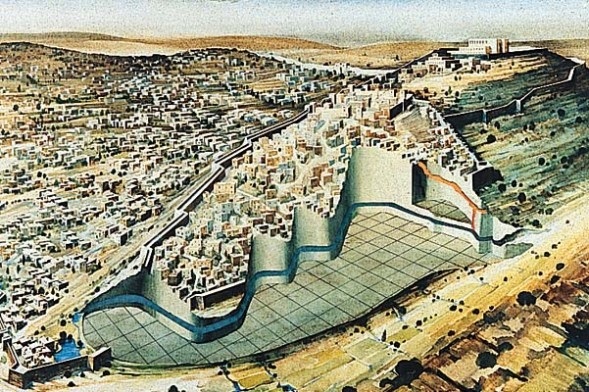
I CHRONICLES 11:7-8 ~ Then David made his home in the fortress. That is why it is named the City of David. David built the city around the fort. He built it from the Millo to the wall around the city. Joab repaired the other parts of the city. = أخبار الأيام الأول الفصل 11
7 وَأَقَامَ دَاوُدُ فِي الْحِصْنِ, لِذَلِكَ دَعُوهُ «مَدِينَةَ دَاوُدَ».
8 وَبَنَى الْمَدِينَةَ حَوَالَيْهَا مِنَ الْقَلْعَةِ إِلَى مَا حَوْلِهَا. وَيُوآبُ جَدَّدَ سَائِرَ الْمَدِينَةِ.
400 feet of the remains of the old Jebus foundations are still visible under David’s masonry. More recently the ruins of a house built during the time the Jebusites controlled the fortress has been discovered.
I CHRONICLES 11:16-17 ~ Another time, David was in the fortress, and a group of Philistine soldiers was in Bethlehem. David was thirsty {for some water from his home town}. So he said, “I wish someone could give me some water from that well near the city gate in Bethlehem.” = أخبار الأيام الأول الفصل 11
16 وَكَانَ دَاوُدُ حِينَئِذٍ فِي الْحِصْنِ, وَحَفَظَةُ الْفِلِسْطِينِيِّينَ حِينَئِذٍ فِي بَيْتِ لَحْمٍ.
17 فَتَأَوَّهَ دَاوُدُ وَقَالَ: «مَنْ يَسْقِينِي مَاءً مِنْ بِئْرِ بَيْتِ لَحْمٍ الَّتِي عِنْدَ الْبَابِ؟»
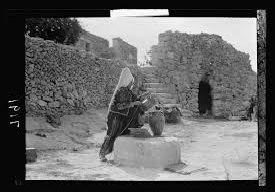
The well just inside the city wall of Bethlehem. It was taken in the late 1800s before the city grew and was commercialized. (Today it is a suburb of Jerusalem.)
II CHRONICLES 11:5-7~ Rehoboam lived in Jerusalem. He built strong cities in Judah to defend against attacks. He repaired the cities of Bethlehem, Etam, Tekoa, Beth Zur, Soco, Adullam, Gath, Mareshah, Ziph, Adoraim, Lachish, Azekah = أخبار الأيام الأول الفصل 11
5 وَقَالَ سُكَّانُ يَبُوسَ لِدَاوُدَ: «لاَ تَدْخُلْ إِلَى هُنَا». فَأَخَذَ دَاوُدُ حِصْنَ صِهْيَوْنَ (هِيَ مَدِينَةُ دَاوُدَ).
6 وَقَالَ دَاوُدُ: «إِنَّ الَّذِي يَضْرِبُ الْيَبُوسِيِّينَ أَوَّلاً يَكُونُ رَأْساً وَقَائِداً». فَصَعِدَ أَوَّلاً يُوآبُ ابْنُ صَرُويَةَ, فَصَارَ رَأْساً.
7 وَأَقَامَ دَاوُدُ فِي الْحِصْنِ, لِذَلِكَ دَعُوهُ «مَدِينَةَ دَاوُدَ».
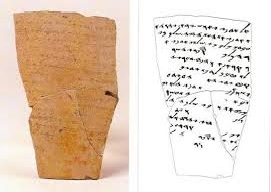
A Lachish letter
The ruins of several of these cities have already been noted above: Bethlehem, Adullam, Gath, Ziph, and Hebron. Two more of these cities have been verified in the Lachish letters.
The Lachish letters were written on clay shards at a later time by the commander of Lachish while it was being attacked and are currently on display at the British Museum in London. Among them were Lachish and Azekah. Letter IV of the Lachish letters said this:
“I will send for him tomorrow at daylight. And let it be known to my master that we will be looking for the signals from Lachish, according to the instructions which he has given, for no signals from Azekah have been seen.”

Wall of prisoners at Shishak’s palace in Karnak.
II CHRONICLES 12:2-4 ~ Shishak attacked the city of Jerusalem in the fifth year that Rehoboam was king. Shishak was the king of Egypt…. Shishak had 12,000 chariots, 60,000 horse riders, and an army that no person could count. In Shishak’s large army there were Libyan soldiers, Sukkite soldiers, and Ethiopian soldiers. Shishak defeated the strong cities of Judah. Then Shishak brought his army to Jerusalem. = أخبار الأيام الأول الفصل 12
2 نَازِعُونَ فِي الْقِسِيِّ, يَرْمُونَ الْحِجَارَةَ وَالسِّهَامَ مِنَ الْقِسِيِّ بِالْيَمِينِ وَالْيَسَارِ, مِنْ إِخْوَةِ شَاوُلَ مِنْ بِنْيَامِينَ.
3 الرَّأْسُ أَخِيعَزَرُ ثُمَّ يُوآشُ ابْنَا شَمَاعَةَ الْجِبْعِيُّ, وَيَزُوئِيلُ وَفَالَطُ ابْنَا عَزْمُوتَ, وَبَرَاخَةُ وَيَاهُو الْعَنَاثُوثِيُّ,
4 وَيَشْمَعْيَا الْجِبْعُونِيُّ الْبَطَلُ بَيْنَ الثَّلاَثِينَ وَعَلَى الثَّلاَثِينَ, وَيَرْمِيَا وَيَحْزِيئِيلُ وَيُوحَانَانُ وَيُوزَابَادُ الْجَدِيرِيُّ
Pharaoh Shishak’s record of this campaign is inscribed on the south wall of the great Temple of Amon at Karnak in which he is depicted as presenting 156 cities of Palestine to his god Amon. This was in 609 BC. Although the names of some of the cities are hard to read, here are a few: Taanach, Beth-Shean, Rehob, Mahanaim, Gibeon, Beth-Horon, Megiddo, and Arad.
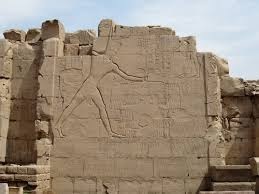
Pharaoh Shishak’s wall of victory
Further, Part of a monument Shishak set up in Megiddo has been discovered. Excavations of Megiddo are shown above. Megiddo was a very strategic city.
II CHRONICLES 26:3, 15 ~ Uzziah was 16 years old when he became king. He ruled 52 years in Jerusalem …. Uzziah became famous. People knew his name in far away places. He had much help and became a powerful king. = أخبار الأيام الثاني الفصل 26
3 كَانَ عُزِّيَّا ابْنَ سِتَّ عَشَرَةَ سَنَةً حِينَ مَلَكَ وَمَلَكَ اثْنَتَيْنِ وَخَمْسِينَ سَنَةً فِي أُورُشَلِيمَ. وَاسْمُ أُمِّهِ يَكُلْيَا مِنْ أُورُشَلِيمَ.
15 وَعَمِلَ فِي أُورُشَلِيمَ مَنْجَنِيقَاتٍ اخْتِرَاعَ مُخْتَرِعِينَ لِتَكُونَ عَلَى الأَبْرَاجِ وَعَلَى الزَّوَايَا لِتُرْمَى بِهَا السِّهَامُ وَالْحِجَارَةُ الْعَظِيمَةُ. وَامْتَدَّ اسْمُهُ إِلَى بَعِيدٍ إِذْ عَجِبَتْ مُسَاعَدَتُهُ حَتَّى تَشَدَّدَ.
Tiglath Pileser recorded his war victories on engraved wall panels (reliefs) in his palace. Many of them are on display at the British Museum in London. On one of them, he brags that he took cities away from the powerful King Azariah/Uzzah.

“Nineteen districts of the city of Hamath, together with the towns in their circuit, situated on the sea of the setting sun [the Mediterranean], which in their faithlessness had joined faith with Azariah, I restored to the territory of the land of Asshur.”
In another place he lists Azariah as “Azariah the Judean.”
In still another panel, it is stated that in the fifth year of Tiglath Pileser‘s reign, he enjoyed a victory over Azariah (Uzziah), king of Judah. He was apparently referring to the cities he took from him.
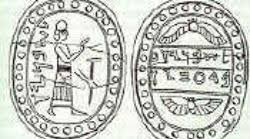
Two seals bearing the name of Uzziah have been discovered along with several other seals at El-kheleifeh ~ Gibeon Ezer.
One says: “Abyaw, steward of Uzziah”
The other says: “Shebnayahu, official to Uzziah”
II CHRONICLES 26:16, 18, 20-21, 23 But when Uzziah became strong, his pride caused him to be destroyed. ..He went into the Lord’s temple to burn incense on the altar for burning incense….“Uzziah, it is not your job to burn incense to the Lord….priests were trained for holy service to burn incense”….They could see the leprosy on his forehead. The priests quickly forced Uzziah out from the temple….Uzziah the king was a leper. Uzziah died and was buried near his ancestors. Uzziah was buried in the field near the kings’ burial places. Why? Because the people said, “Uzziah has leprosy.” = أخبار الأيام الثاني الفصل 26
16 وَلَمَّا تَشَدَّدَ ارْتَفَعَ قَلْبُهُ إِلَى الْهَلاَكِ وَخَانَ الرَّبَّ إِلَهَهُ وَدَخَلَ هَيْكَلَ الرَّبِّ لِيُوقِدَ عَلَى مَذْبَحِ الْبَخُورِ.
18 وَقَاوَمُوا عُزِّيَّا الْمَلِكَ وَقَالُوا لَهُ: [لَيْسَ لَكَ يَا عُزِّيَّا أَنْ تُوقِدَ لِلرَّبِّ بَلْ لِلْكَهَنَةِ بَنِي هَارُونَ الْمُقَدَّسِينَ لِلإِيقَادِ.
20 فَالْتَفَتَ نَحْوَهُ عَزَرْيَاهُو الْكَاهِنُ الرَّأْسُ وَكُلُّ الْكَهَنَةِ وَإِذَا هُوَ أَبْرَصُ فِي جَبْهَتِهِ فَطَرَدُوهُ مِنْ هُنَاكَ حَتَّى إِنَّهُ هُوَ نَفْسُهُ بَادَرَ إِلَى الْخُرُوجِ لأَنَّ الرَّبَّ ضَرَبَهُ.
21 وَكَانَ عُزِّيَّا الْمَلِكُ أَبْرَصَ إِلَى يَوْمِ وَفَاتِهِ وَأَقَامَ فِي بَيْتِ الْمَرَضِ أَبْرَصَ لأَنَّهُ قُطِعَ مِنْ بَيْتِ الرَّبِّ وَكَانَ يُوثَامُ ابْنُهُ عَلَى بَيْتِ الْمَلِكِ يَحْكُمُ عَلَى شَعْبِ الأَرْضِ.
23 ثُمَّ اضْطَجَعَ عُزِّيَّا مَعَ آبَائِهِ وَدَفَنُوهُ مَعَ آبَائِهِ فِي حَقْلِ الْمَِقْبَرَةِ الَّتِي لِلْمُلُوكِ لأَنَّهُمْ قَالُوا إِنَّهُ أَبْرَصُ. وَمَلَكَ يُوثَامُ ابْنُهُ عِوَضاً عَنْهُ.
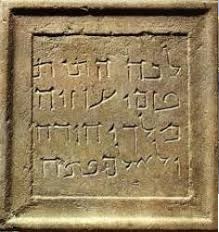
Burial Plaque of leper King Uzziah, Israel Museum
Notice, Uzziah was not buried with his ancestors, but near them. He was also not buried in the kings’ burial places, but near them.
Archaeologist E. I. Sukenik of the Hebrew University of Jerusalem discovered the grave marker of Uzziah on the Mount of Olives across the valley from Jerusalem. This is what is engraved on it:
“Hither were brought the bones of Uzziah, king of Judah.”
It is on display in the Israel Museum in Jerusalem.
II CHRONICLES 26:23; 27:1, 4 ~ And Jotham became the new king in Uzziah’s place. Jotham was Uzziah’s son. Jotham King of Judah Jotham was 25 years old when he became king. He ruled 16 years in Jerusalem….Jotham also built towns in the hill country of Judah. Jotham built fortresses and towers in the forests. = أخبار الأيام الثاني الفصل 26 – أخبار الأيام الثاني الفصل 27
23 ثُمَّ اضْطَجَعَ عُزِّيَّا مَعَ آبَائِهِ وَدَفَنُوهُ مَعَ آبَائِهِ فِي حَقْلِ الْمَِقْبَرَةِ الَّتِي لِلْمُلُوكِ لأَنَّهُمْ قَالُوا إِنَّهُ أَبْرَصُ. وَمَلَكَ يُوثَامُ ابْنُهُ عِوَضاً عَنْهُ.
1 كَانَ يُوثَامُ ابْنَ خَمْسٍ وَعِشْرِينَ سَنَةً حِينَ مَلَكَ وَمَلَكَ سِتَّ عَشَرَةَ سَنَةً فِي أُورُشَلِيمَ وَاسْمُ أُمِّهِ يَرُوشَةُ بِنْتُ صَادُوقَ.
4 وَبَنَى مُدُناً فِي جَبَلِ يَهُوذَا وَبَنَى فِي الْغَابَاتِ قِلَعاً وَأَبْرَاجاً.
Also among the seals found at El-kheleifeh ~ Gibeon Ezer ~ was a signate ring of Jothan. It was found by Nelson Glueck of Hebrew Union College, the Jewish Institute of religion.
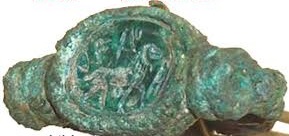
I CHRONICLES 27:9; 28:1 ~ Ahaz became the king in Jotham’s place. Ahaz was Jotham’s son. Ahaz King of Judah Ahaz was 20 years old when he became king. He ruled 16 years in Jerusalem. = أخبار الأيام الثاني الفصل 27 – أخبار الأيام الثاني الفصل 28
9 ثُمَّ اضْطَجَعَ يُوثَامُ مَعَ آبَائِهِ فَدَفَنُوهُ فِي مَدِينَةِ دَاوُدَ وَمَلَكَ آحَازُ ابْنُهُ عِوَضاً عَنْهُ.
1 كَانَ آحَازُ ابْنَ عِشْرِينَ سَنَةً حِينَ مَلَكَ وَمَلَكَ سِتَّ عَشَرَةَ سَنَةً فِي أُورُشَلِيمَ وَلَمْ يَفْعَلِ الْمُسْتَقِيمَ فِي عَيْنَيِ الرَّبِّ كَدَاوُدَ أَبِيهِ
Two clay seal imprints called bulla have been discovered bearing the name of King Ahaz.
The first seal, is displayed by the Yale University library, and reads: “Ushna, an attendant of Ahaz.”
Ahaz’s second seal is in the Shlomo Moussaieff Collection, London, is rust colored. The seal reads: “Ahaz (son of) Jotham, Judah’s king.”


Top, seal of AHAZ.
II CHRONICLES 28:16, 20-21 ~ King Ahaz asked the king of Assyria to help him….Tiglath Pileser king of Assyria came and gave Ahaz trouble instead of helping him. Ahaz took some valuable things from the Lord’s temple and from the king’s house and from the prince’s house. Ahaz gave those things to the king of Assyria. But that didn’t help Ahaz. = أخبار الأيام الثاني الفصل 28
16 فِي ذَلِكَ الْوَقْتِ أَرْسَلَ الْمَلِكُ آحَازُ إِلَى مُلُوكِ أَشُّورَ لِيُسَاعِدُوهُ.
20 فَجَاءَ عَلَيْهِ تَغْلَثَ فَلاَسَرُ مَلِكُ أَشُّورَ وَضَايَقَهُ وَلَمْ يُشَدِّدْهُ.
21 لأَنَّ آحَازَ أَخَذَ قِسْماً مِنْ بَيْتِ الرَّبِّ وَمِنْ بَيْتِ الْمَلِكِ وَمِنَ الرُّؤَسَاءِ وَأَعْطَاهُ لِمَلِكِ أَشُّورَ وَلَكِنَّهُ لَمْ يُسَاعِدْهُ.
An inscription on one of the wall panels of Tiglath-Pileser III in his palace giving accounts of his battles and making of minor kings his puppets reads as follows:
“From these I received tribute . . . Ahaz, the king of Judah . . . including gold, silver, iron, fine cloth and many garments made from wool that was dyed in purple.”
II CHRONICLES 28:27; 29:1 ~ Hezekiah became the new king in Ahaz’s place. Hezekiah was Ahaz’s son. Hezekiah became king when he was 25 years old. He ruled 29 years in Jerusalem. = أخبار الأيام الثاني الفصل 28 – أخبار الأيام الثاني الفصل 29
7 ثُمَّ اضْطَجَعَ آحَازُ مَعَ آبَائِهِ فَدَفَنُوهُ فِي الْمَدِينَةِ فِي أُورُشَلِيمَ لأَنَّهُمْ لَمْ يَأْتُوا بِهِ إِلَى قُبُورِ مُلُوكِ إِسْرَائِيلَ. وَمَلَكَ حَزَقِيَّا ابْنُهُ عِوَضاً عَنْهُ.
1 مَلَكَ حَزَقِيَّا وَهُوَ ابْنُ خَمْسٍ وَعِشْرِينَ سَنَةً وَمَلَكَ تِسْعاً وَعِشْرِينَ سَنَةً فِي أُورُشَلِيمَ وَاسْمُ أُمِّهِ أَبِيَّةُ بِنْتُ زَكَرِيَّا.
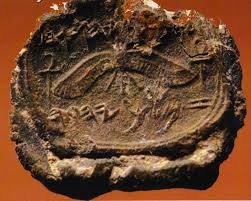
Seal impressions have been found in modern Israel relating to King Hezekiah on storage jar handles excavated from ruins left in Sennacherib’s destruction and immediately above that layer.
Also, clay impressions from the signet ring (bulla) off of royal sealed documents, some that may have belonged to Hezekiah himself.
II CHRONICLES 32:1~ After all these things that Hezekiah had faithfully done happened, Sennacherib king of Assyria came to attack the country of Judah. Sennacherib and his army camped outside the fortresses. He did this so he could make plans to defeat those towns. Sennacherib wanted to win those towns for himself. = أخبار الأيام الثاني الفصل 32
1 وَبَعْدَ هَذِهِ الأُمُورِ وَهَذِهِ الأَمَانَةِ أَتَى سَنْحَارِيبُ مَلِكُ أَشُّورَ وَدَخَلَ يَهُوذَا وَنَزَلَ عَلَى الْمُدُنِ الْحَصِينَةِ وَطَمِعَ بِإِخْضَاعِهَا لِنَفْسِهِ.

Sennacherib’s prism in British Museum
Assyrian King Sennacherib’s account of his invasion of Judah is on a clay prism now on display at the Oriental Institute Museum of Chicago. It reads as follows in column three, lines 18-27:
18As for Hezekiah the Judahite, 19who did not submit to my yoke: forty-six of his strong, walled cities, as well as 20the small towns in their area, 21which were without number, by levelling with battering-rams 22and by bringing up seige-engines, and by attacking and storming on foot, 23by mines, tunnels, and breeches, I besieged and took them. 24200,150 people, great and small, male and female, 25horses, mules, asses, camels, 26cattle and sheep without number, I brought away from them 27and counted as spoil….
II CHRONICLES 32:2 ~ Hezekiah knew that Sennacherib came to[ward] Jerusalem to attack it. Then Hezekiah talked to his officials and army officers. They all agreed to stop the waters of the water springs outside the city. Those officials and army officers helped Hezekiah. = أخبار الأيام الثاني الفصل 32
2 وَلَمَّا رَأَى حَزَقِيَّا أَنَّ سَنْحَارِيبَ قَدْ أَتَى وَوَجْهُهُ عَلَى مُحَارَبَةِ أُورُشَلِيمَ
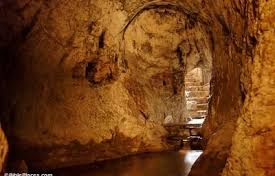
Hezekiah’s water tunnel
Hezekiah made sure that Jerusalem had water during the months or years he anticipated Sennacherib would be camped outside the city trying to lay siege to it. Hezekiah’s Water Tunnel (also called the Siloam Tunnel) was dug underneath the City of David in Jerusalem before 701 BC during the reign of Hezekiah.
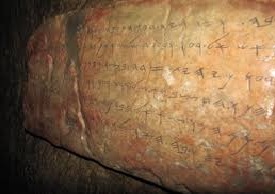
Hezekiah’s inscription inside his tunnel
The Gihon Spring was at the east foot of Ophel Hill just outside the wall of Jerusalem. Hezekiah’s workmen cut a tunnel through solid rock under the hill, running 1700 feet SW from the spring to the Pool of Siloam inside the wall, thus diverting the water of the Spring from its natural flow into the Brook Kidron. The tunnel is about 6 feet tall and 2 ½ feet wide.
Nineteen feet from the opening of the tunnel was an inscription which is now in the Constantinople Museum. Apparently it was begun at both ends, and they worked toward each others’ voices. This is what the inscriptions says:
“The Tunnel is completed. And this is the story of the tunnel. While the stone cutters were lifting up the pick, each toward his neighbor (from opposite ends), and while they were yet 3 cubits apart, there was heard a voice of one calling to another; and after that pick struck against pick, and the waters flowed from the spring to the pool, 1200 cubits, and 100 cubits was the height of the rock above.”
II CHRONICLES 32:5 ~ Hezekiah made Jerusalem stronger. This is how he did it: He built again all the parts of the wall that were broken down. He built towers on the wall. He also built another wall outside the first wall. He built again the strong places on the east side of the old part of Jerusalem. = أخبار الأيام الثاني الفصل 32
5 وَتَشَدَّدَ وَبَنَى كُلَّ السُّورِ الْمُنْهَدِمِ وَأَعْلاَهُ إِلَى الأَبْرَاجِ وَسُوراً آخَرَ خَارِجاً وَحَصَّنَ الْقَلْعَةَ مَدِينَةَ دَاوُدَ وَعَمِلَ سِلاَحاً بِكَِثْرَةٍ وَأَتْرَاساً.
Parts of Hezekiah’s second wall, sometimes also called the Broad Wall, enclosed the western hill beside Old Jerusalem, the City of David. The new wall was 30 feet from the old inner wall. It increased the walled area of Jerusalem five-fold so that many citizens of Judea could move into the city for protection.
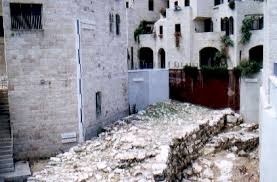
Hezekiah’s broad wall
II CHRONICLES 32:9a ~ Sennacherib king of Assyria and all his army were camped near the town of Lachish so they could defeat it. = أخبار الأيام الثاني الفصل 32
9 بَعْدَ هَذَا أَرْسَلَ سَنْحَارِيبُ مَلِكُ أَشُّورَ عَبِيدَهُ إِلَى أُورُشَلِيمَ. (وَهُوَ عَلَى لَخِيشَ وَكُلُّ سَلْطَنَتِهِ مَعَهُ) إِلَى حَزَقِيَّا مَلِكِ يَهُوذَا وَإِلَى كُلِّ يَهُوذَا الَّذِينَ فِي أُورُشَلِيمَ يَقُولُونَ:
During all the fortifying of Jerusalem, Assyria’s King Sennacherib was gradually working his way through Judea destroying city after city, even of nearby kingdoms, so he could not call on anyone for help.
Lines 31-36 of his prism reported his takeover of nearby kingdoms which he said the powerful Hezekiah controlled. On line 36 of his prism, he says,
“I laid upon him [Hezekiah] the surrender of their land and imposts gifts for my majesty.”
He then moved on to conquer the city of Lachish. Now at the British Museum in London and pictured here, is a small section of an alabaster panel from Sennacherib’s palace in Nineveh that originally measured about 8′ tall by 80′ long depicting his conquest of Lachish with the cuneiform text,
“Sennacherib, king of the world, king of Assyria, set upon his throne of state, and caused the spoil of Lachish to pass before him.”
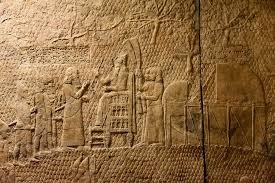
Sennacherib’s victory over Lachish. Panel is in the British Museum
18 وَصَرَخُوا بِصَوْتٍ عَظِيمٍ بِالْيَهُودِيِّ إِلَى شَعْبِ أُورُشَلِيمَ الَّذِينَ عَلَى السُّورِ لِتَخْوِيفِهِمْ وَتَرْوِيعِهِمْ لِيَأْخُذُوا الْمَدِينَةَ.
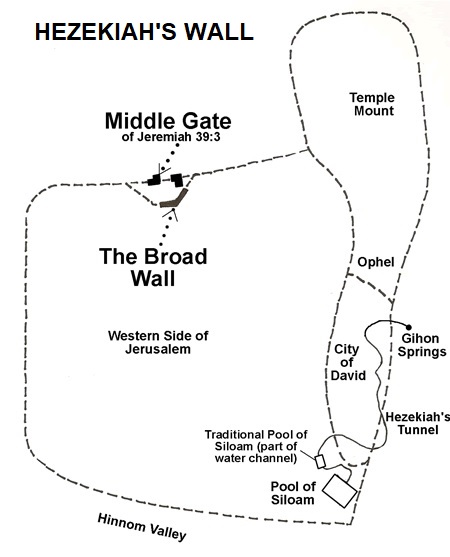
On Sennacherib’s prism is this in column 3, lines 27-30, 37-40 is his account:
(Hezekiah) himself, like a caged bird 28I shut up in Jerusalem, his royal city. 29I threw up earthworks against him‹ 30the one coming out of the city-gate, I turned back to his misery. 37As for Hezekiah, 38the terrifying splendor of my majesty overcame him, and 39the Arabs and his mercenary troops which he had brought in to strengthen 40Jerusalem, his royal city, 41deserted him.

Sennacherib’s archers from Nineveh palace wall panel
II CHRONICLES 32:21a ~ Then the Lord sent an angel to the king of Assyria’s camp. That angel killed [disease?] all the soldiers and the leaders and the officers in the Assyrian army. So the king of Assyria went back home to his own country, and his people were ashamed of him. = أخبار الأيام الثاني الفصل 32
21 فَأَرْسَلَ الرَّبُّ مَلاَكاً فَأَبَادَ كُلَّ جَبَّارِ بَأْسٍ وَرَئِيسٍ وَقَائِدٍ فِي مَحَلَّةِ مَلِكِ أَشُّورَ. فَرَجَعَ بِخِزْيِ الْوَجْهِ إِلَى أَرْضِهِ. وَلَمَّا دَخَلَ بَيْتَ إِلَهِهِ قَتَلَهُ هُنَاكَ بِالسَّيْفِ الَّذِينَ خَرَجُوا مِنْ أَحْشَائِهِ.
Sennacherib could not claim complete victory over Jerusalem. All he had to brag about on his prism was what Hezekiah sent out to him as recorded in II Kings of the Bible. This is how the prism reads:
In addition to the thirty talents of gold and 42eight hundred talents of silver, gems, antimony, 43jewels, large carnelians, ivory-inlaid couches, 44ivory-inlaid chairs, elephant hides, elephant tusks, 45ebony, boxwood, all kinds of valuable treasures, 46as well as his daughters, his harem, his male and female 47musicians, which he had brought after me 48to Nineveh, my royal city. To pay tribute 49and to accept servitude, he dispatched his messengers.
II CHRONICLES 32:21b ~ So the king of Assyria went back home to his own country, and his people were ashamed of him. He went into the temple of his god and some of his own sons killed him there with a sword. = أخبار الأيام الثاني الفصل 3
21 فَأَرْسَلَ الرَّبُّ مَلاَكاً فَأَبَادَ كُلَّ جَبَّارِ بَأْسٍ وَرَئِيسٍ وَقَائِدٍ فِي مَحَلَّةِ مَلِكِ أَشُّورَ. فَرَجَعَ بِخِزْيِ الْوَجْهِ إِلَى أَرْضِهِ. وَلَمَّا دَخَلَ بَيْتَ إِلَهِهِ قَتَلَهُ هُنَاكَ بِالسَّيْفِ الَّذِينَ خَرَجُوا مِنْ أَحْشَائِهِ.
A clay tablet found in the ancient archives of Assyria and now on display at the British Museum in London reads thusly:
“On the 20th day of the month Tebet, Sennacharib king of Assyria his son slew him in rebellion….On the 18th day of Sivan Esar-haddon his son sat on the throne of Assyria.”
II CHRONICLES 32:33; 33:1 ~ Manasseh became the new king in Hezekiah’s place. Manasseh was Hezekiah’s son. Manasseh King of Judah Manasseh was twelve years old when he became king of Judah. He was king for 55 years in Jerusalem. = أخبار الأيام الثاني الفصل 32 – أخبار الأيام الثاني الفصل 33
33 ثُمَّ اضْطَجَعَ حَزَقِيَّا مَعَ آبَائِهِ فَدَفَنُوهُ فِي عَقَبَةِ قُبُورِ بَنِي دَاوُدَ وَعَمِلَ لَهُ إِكْرَاماً عِنْدَ مَوْتِهِ كُلُّ يَهُوذَا وَسُكَّانِ أُورُشَلِيمَ. وَمَلَكَ مَنَسَّى ابْنُهُ عِوَضاً عَنْهُ.
1 كَانَ مَنَسَّى ابْنَ اثْنَتَيْ عَشْرَةَ سَنَةً حِينَ مَلَكَ وَمَلَكَ خَمْساً وَخَمْسِينَ سَنَةً فِي أُورُشَلِيمَ.
An inscription of Esar-haddon, Assyrian king, 681-668 BC says,

II CHRONICLES 34:8-9 ~ So Josiah commanded the temple to be fixed so he could make Judah and the temple clean. Those men came to Hilkiah the high priest. They gave him the money that people gave for God’s temple. = أخبار الأيام الثاني الفصل 34
8 وَفِي السَّنَةِ الثَّامِنَةَ عَشَرَةَ مِنْ مُلْكِهِ بَعْدَ أَنْ طَهَّرَ الأَرْضَ وَالْبَيْتَ أَرْسَلَ شَافَانَ بْنَ أَصَلْيَا وَمَعْسِيَّا رَئِيسَ الْمَدِينَةِ وَيُوآخَ بْنَ يُوآحَازَ الْمُسَجِّلَ لأَجْلِ تَرْمِيمِ بَيْتِ الرَّبِّ إِلَهِهِ.
9 فَجَاءُوا إِلَى حِلْقِيَّا الْكَاهِنِ الْعَظِيمِ وَأَعْطُوهُ الْفِضَّةَ الْمُدْخَلَةَ إِلَى بَيْتِ اللَّهِ الَّتِي جَمَعَهَا اللاَّوِيُّونَ حَارِسُو الْبَابِ مِنْ مَنَسَّى وَأَفْرَايِمَ وَمِنْ كُلِّ بَقِيَّةِ إِسْرَائِيلَ وَمِنْ كُلِّ يَهُوذَا وَبِنْيَامِينَ ثُمَّ رَجَعُوا إِلَى أُورُشَلِيمَ.
A seal bearing the name “Azariah son of Hilkiah” has been found In 1975, nearly 250 clay seals were discovered about 45 miles southwest of Jerusalem. These seals were used to seal letters and documents to make them officially from the person owning the seal. Often the seal was also a ring.

Seal of Azariah son of Hilkiah
A bulla is the imprint from a signet ring with the person’s seal. The Archaeological Encyclopedia of the Holy Land lists these bullae that have been unearthed: 50 in Samaria during the 1930s; 17 at Lachish in 1966; 51 in Jerusalem in digs conducted by Yigal Shiloh; 128 in 1962 found in the Wadi ed-Daliyeh Cave and a large cache of 2,000 bullae found in 1998 at Tel Kadesh. They are usually small, oval, clay stamps that contain the name of the person responsible for the document that was sealed (and occasionally the father of that person), the title or office of the sealer, and/or a picture of an animal or
some other artistic rendering.
